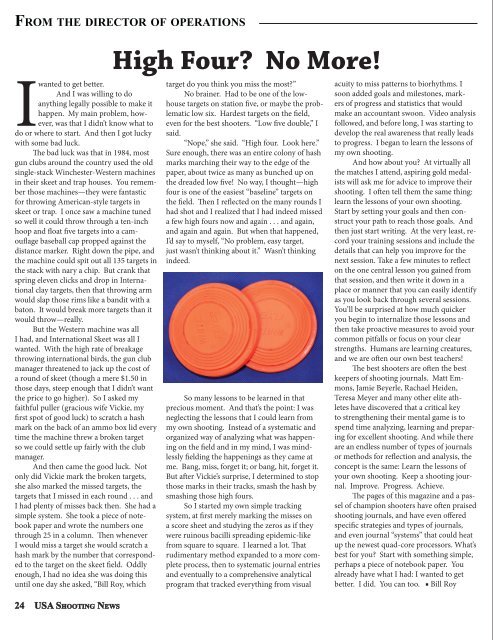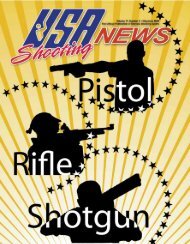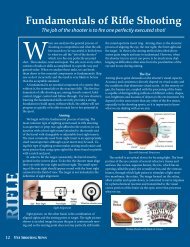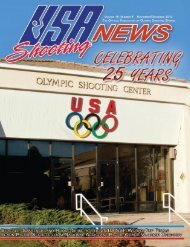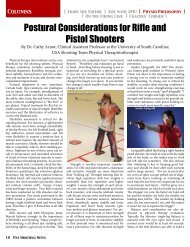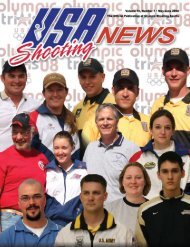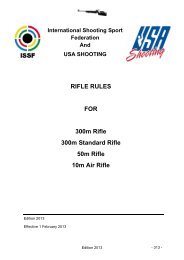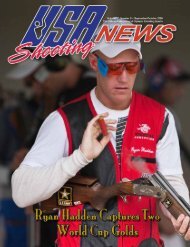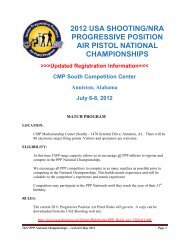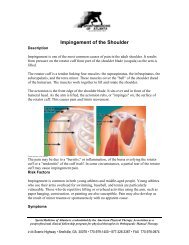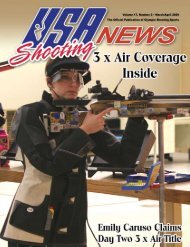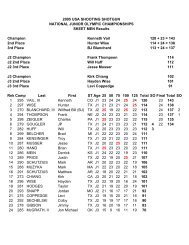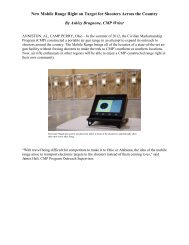January/February 2011: Volume 19, Number 1 - USA Shooting
January/February 2011: Volume 19, Number 1 - USA Shooting
January/February 2011: Volume 19, Number 1 - USA Shooting
Create successful ePaper yourself
Turn your PDF publications into a flip-book with our unique Google optimized e-Paper software.
From the director of operations<br />
I<br />
wanted to get better.<br />
And I was willing to do<br />
anything legally possible to make it<br />
happen. My main problem, however,<br />
was that I didn’t know what to<br />
do or where to start. And then I got lucky<br />
with some bad luck.<br />
The bad luck was that in <strong>19</strong>84, most<br />
gun clubs around the country used the old<br />
single-stack Winchester-Western machines<br />
in their skeet and trap houses. You remember<br />
those machines—they were fantastic<br />
for throwing American-style targets in<br />
skeet or trap. I once saw a machine tuned<br />
so well it could throw through a ten-inch<br />
hoop and float five targets into a camouflage<br />
baseball cap propped against the<br />
distance marker. Right down the pipe, and<br />
the machine could spit out all 135 targets in<br />
the stack with nary a chip. But crank that<br />
spring eleven clicks and drop in International<br />
clay targets, then that throwing arm<br />
would slap those rims like a bandit with a<br />
baton. It would break more targets than it<br />
would throw—really.<br />
But the Western machine was all<br />
I had, and International Skeet was all I<br />
wanted. With the high rate of breakage<br />
throwing international birds, the gun club<br />
manager threatened to jack up the cost of<br />
a round of skeet (though a mere $1.50 in<br />
those days, steep enough that I didn’t want<br />
the price to go higher). So I asked my<br />
faithful puller (gracious wife Vickie, my<br />
first spot of good luck) to scratch a hash<br />
mark on the back of an ammo box lid every<br />
time the machine threw a broken target<br />
so we could settle up fairly with the club<br />
manager.<br />
And then came the good luck. Not<br />
only did Vickie mark the broken targets,<br />
she also marked the missed targets, the<br />
targets that I missed in each round . . . and<br />
I had plenty of misses back then. She had a<br />
simple system. She took a piece of notebook<br />
paper and wrote the numbers one<br />
through 25 in a column. Then whenever<br />
I would miss a target she would scratch a<br />
hash mark by the number that corresponded<br />
to the target on the skeet field. Oddly<br />
enough, I had no idea she was doing this<br />
until one day she asked, “Bill Roy, which<br />
24 <strong>USA</strong> <strong>Shooting</strong> News<br />
High Four? No More!<br />
target do you think you miss the most?”<br />
No brainer. Had to be one of the lowhouse<br />
targets on station five, or maybe the problematic<br />
low six. Hardest targets on the field,<br />
even for the best shooters. “Low five double,” I<br />
said.<br />
“Nope,” she said. “High four. Look here.”<br />
Sure enough, there was an entire colony of hash<br />
marks marching their way to the edge of the<br />
paper, about twice as many as bunched up on<br />
the dreaded low five! No way, I thought—high<br />
four is one of the easiest “baseline” targets on<br />
the field. Then I reflected on the many rounds I<br />
had shot and I realized that I had indeed missed<br />
a few high fours now and again . . . and again,<br />
and again and again. But when that happened,<br />
I’d say to myself, “No problem, easy target,<br />
just wasn’t thinking about it.” Wasn’t thinking<br />
indeed.<br />
So many lessons to be learned in that<br />
precious moment. And that’s the point: I was<br />
neglecting the lessons that I could learn from<br />
my own shooting. Instead of a systematic and<br />
organized way of analyzing what was happening<br />
on the field and in my mind, I was mindlessly<br />
fielding the happenings as they came at<br />
me. Bang, miss, forget it; or bang, hit, forget it.<br />
But after Vickie’s surprise, I determined to stop<br />
those marks in their tracks, smash the hash by<br />
smashing those high fours.<br />
So I started my own simple tracking<br />
system, at first merely marking the misses on<br />
a score sheet and studying the zeros as if they<br />
were ruinous bacilli spreading epidemic-like<br />
from square to square. I learned a lot. That<br />
rudimentary method expanded to a more complete<br />
process, then to systematic journal entries<br />
and eventually to a comprehensive analytical<br />
program that tracked everything from visual<br />
acuity to miss patterns to biorhythms. I<br />
soon added goals and milestones, markers<br />
of progress and statistics that would<br />
make an accountant swoon. Video analysis<br />
followed, and before long, I was starting to<br />
develop the real awareness that really leads<br />
to progress. I began to learn the lessons of<br />
my own shooting.<br />
And how about you? At virtually all<br />
the matches I attend, aspiring gold medalists<br />
will ask me for advice to improve their<br />
shooting. I often tell them the same thing:<br />
learn the lessons of your own shooting.<br />
Start by setting your goals and then construct<br />
your path to reach those goals. And<br />
then just start writing. At the very least, record<br />
your training sessions and include the<br />
details that can help you improve for the<br />
next session. Take a few minutes to reflect<br />
on the one central lesson you gained from<br />
that session, and then write it down in a<br />
place or manner that you can easily identify<br />
as you look back through several sessions.<br />
You’ll be surprised at how much quicker<br />
you begin to internalize those lessons and<br />
then take proactive measures to avoid your<br />
common pitfalls or focus on your clear<br />
strengths. Humans are learning creatures,<br />
and we are often our own best teachers!<br />
The best shooters are often the best<br />
keepers of shooting journals. Matt Emmons,<br />
Jamie Beyerle, Rachael Heiden,<br />
Teresa Meyer and many other elite athletes<br />
have discovered that a critical key<br />
to strengthening their mental game is to<br />
spend time analyzing, learning and preparing<br />
for excellent shooting. And while there<br />
are an endless number of types of journals<br />
or methods for reflection and analysis, the<br />
concept is the same: Learn the lessons of<br />
your own shooting. Keep a shooting journal.<br />
Improve. Progress. Achieve.<br />
The pages of this magazine and a passel<br />
of champion shooters have often praised<br />
shooting journals, and have even offered<br />
specific strategies and types of journals,<br />
and even journal “systems” that could heat<br />
up the newest quad-core processors. What’s<br />
best for you? Start with something simple,<br />
perhaps a piece of notebook paper. You<br />
already have what I had: I wanted to get<br />
better. I did. You can too. ■ Bill Roy<br />
jan feb <strong>2011</strong>.indd 24<br />
1/3/<strong>2011</strong> 10:46:20 AM


